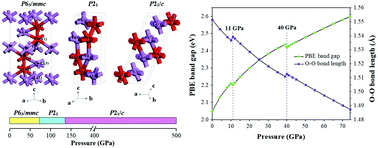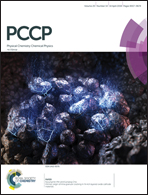Theoretical aspects in structural distortion and the electronic properties of lithium peroxide under high pressure†
Abstract
The structural phase transition and electronic properties of Li2O2 under pressures up to 500 GPa have been investigated using first-principles calculations. Two new structural phase transitions have been proposed at pressures around 75 GPa from the P63/mmc structure to the P21 structure and around 136 GPa from the P21 structure to the P21/c structure. The calculated phonon spectra have confirmed the dynamical stability of these structures. The pressure dependence of the lattice dynamics, O–O bond length, and band gaps in Li2O2 have also been reported. The band gaps of the P63/mmc, P21, and P21/c structures calculated by PBE and HSE06 have shown increasing trends with increasing pressure. Interestingly, the P63/mmc band gap and c/a ratio have significantly decreased with the increasing O–O bond length and ELF value around 11 and 40 GPa. At these pressures, the phonon frequency of the O–O stretching modes has softened. This finding reveals the effects of structural distortion in three phases of Li2O2. Our study provides structural understanding and the electronic properties of Li2O2 under high pressure, which might be useful for investigating the charge transport through Li2O2 in lithium–air batteries and CO2 capture.



 Please wait while we load your content...
Please wait while we load your content...